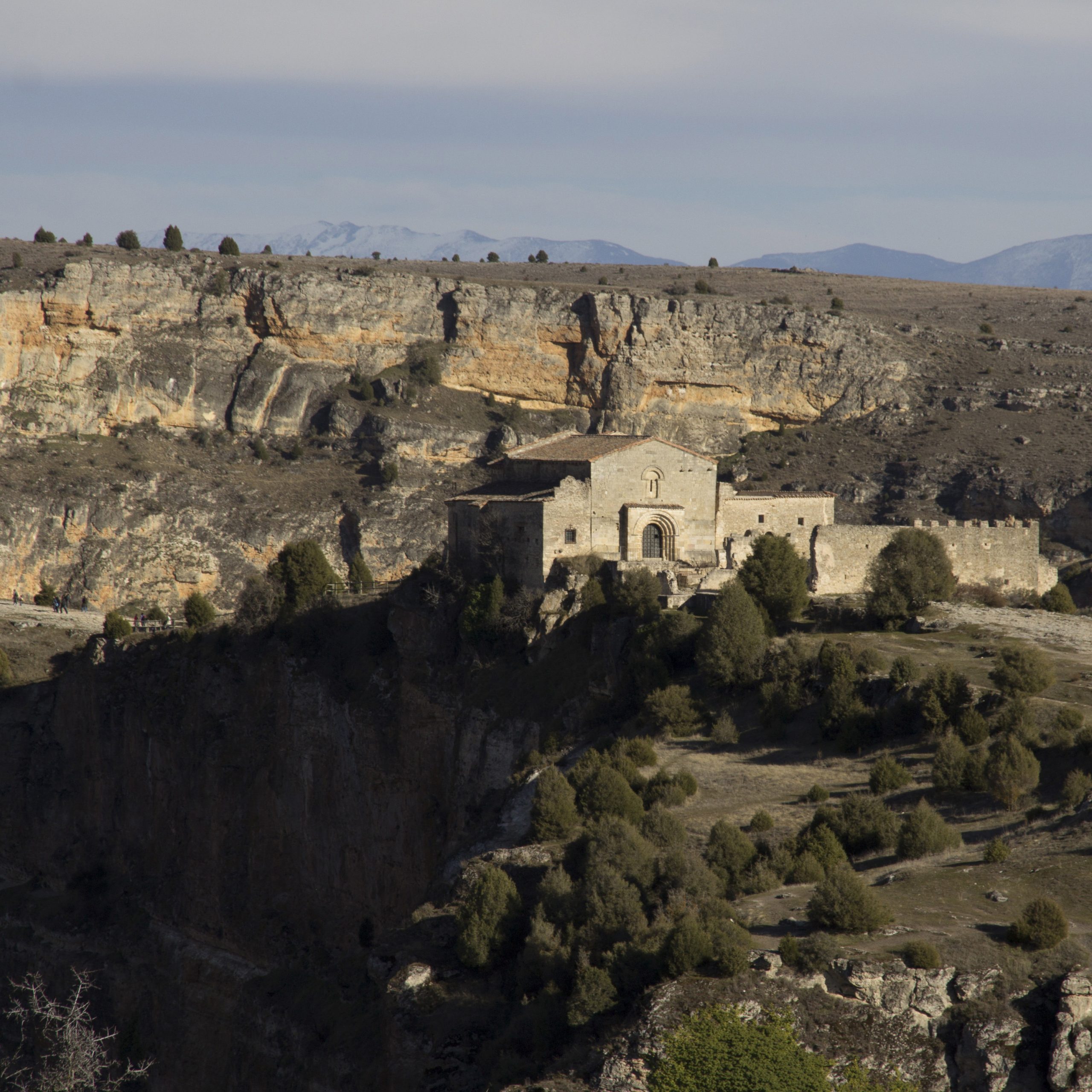“The site of this monastery is one of the roughest, most secluded and frightening in Spain. It is in the bishopric of Segovia. The river Duratón is surrounded by a great rock, which will be half a league in circumference; the rock, from the top of the river, is cut as if it had been cut by hand, and so deep that it is horrifying to look down. At the top of this rock there is a small plain, and on it is the monastery. It has no land even for a small vegetable garden. It has no water. All the ground is a smooth rock. To enter where the monastery is, the rock is cut off, and there is a wooden bridge there, which they say that Saint Frutos, on his way to retreat from the enemies, stabbed the rock with the staff he was carrying and it opened up, leaving him with this cleft, and the siege that the river makes, isolating the small square where the monastery is. Behind the river, this rock is surrounded by other rocks so high that they must be a hundred feet high, and so smooth and cut, that they look like a wall. A musket could not reach from the monastery to these rocks that are that surround it.”
“El sitio de este Monasterio es de los· más ásperos, retirados y espantosos que hay en España. Está en el obispado de Segovia. Ciñe el río Duratón una gran peña, que tendrá en contorno media legua; la peña, desde lo alto del río, es tajada como si la hubieran cortado a mano, y tan profunda, que pone horror mirar abajo. En lo alto de esta peña hay un pequeño llano, y en él está el Monasterio. No tiene t ierra ni aun para una pequeña huerta. No tiene agua. Todo el suelo es una peña lisa. Para entrar donde está el Monasterio está cortada la peña, y allí hay un puente de madera, que dicen que San Frutos, yendo retirándose de los enemigos, dio como una cuchillada en la peña con el báculo que llevaba y se abrió, quedándose con esta hendidura, y el cerco que hace el río aislada la pequeña plaza donde está el Monasterio. Detrás del río cercan este peñasco otras peñas tan altas, que deben de tener cien estados, y tan lisas y cortadas. que parecen un muro. No alcanzaría desde el Monasterio un mosquete a estas peñas que le cercan”
Abad Nebreda
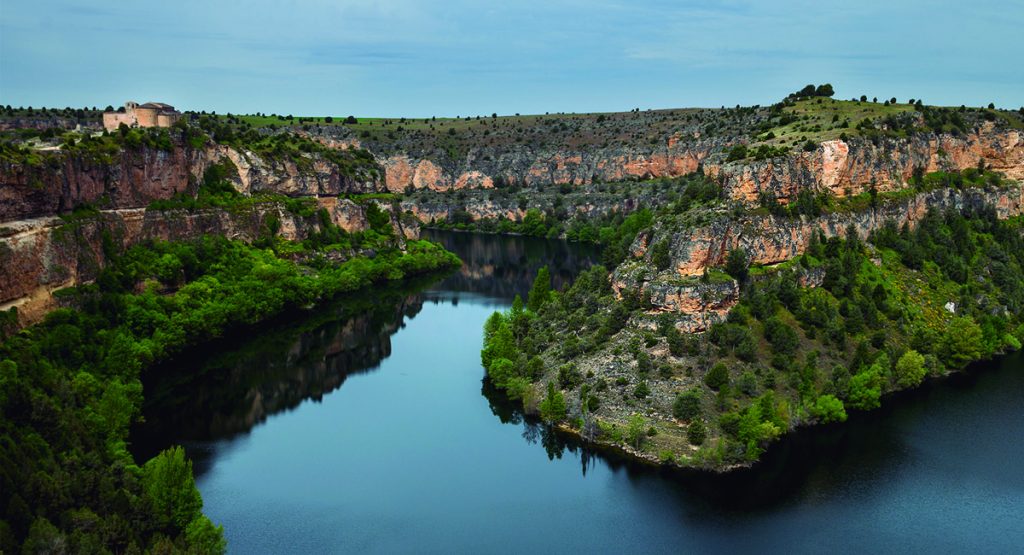
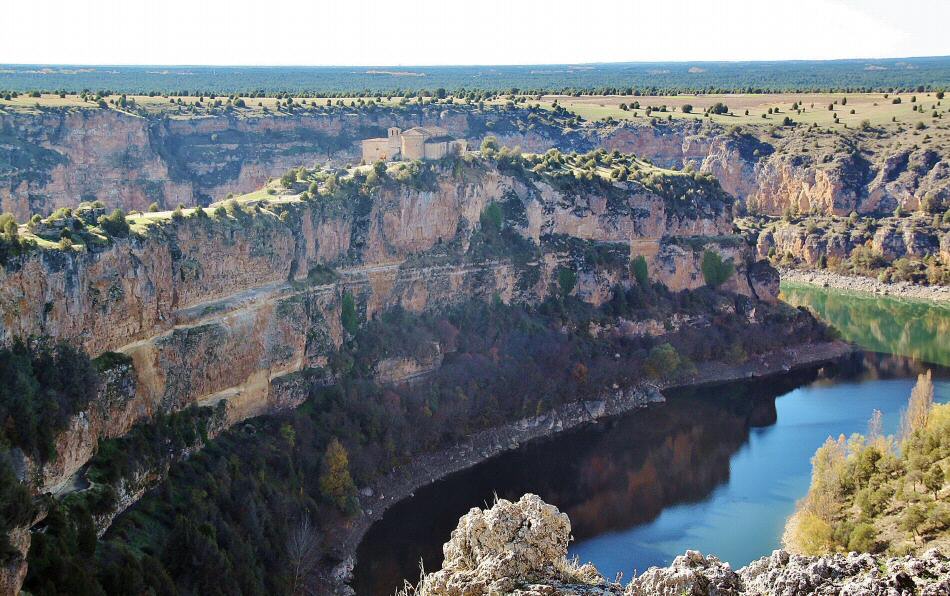
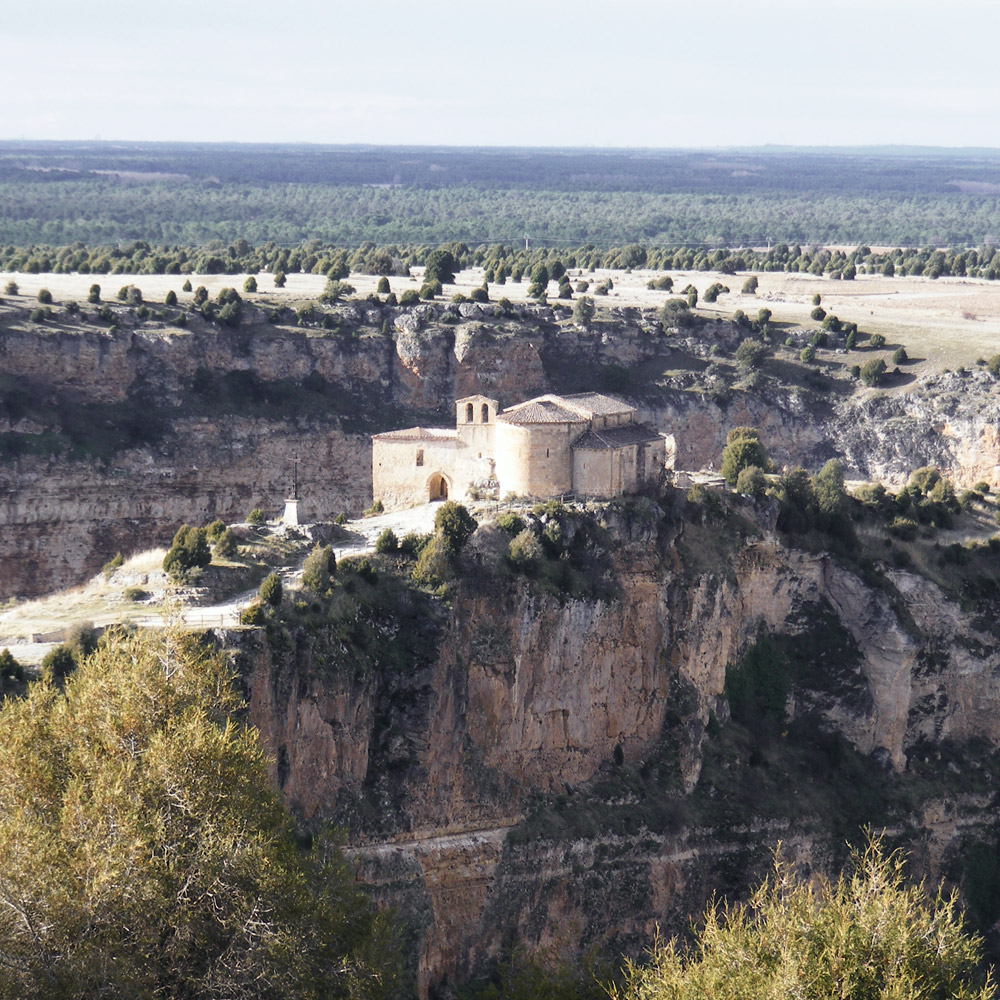
The priory of San Frutos, today known as the hermitage of San Frutos, is the remains of an ancient monastic complex located in the province of Segovia and belonging to the town of Carrascal del Río in Castilla y León (Spain). Ecclesiastically, it belongs to the parish of Sepúlveda. Of the old monastic buildings, only the church dedicated to San Frutos remains standing and active. The monastery complex is located on one of the meanders formed by the gorges of the Duratón river in the heart of the Hoces del río Duratón park and the place that receives the most visitors. Its location, on the edge of the cliff, provides an excellent view of the canyon formed by the Duratón River and the backwater created by the reservoir of the nearby Burgomillodo dam. From here you can see the three different and specific areas that make up the park, the moorland in the upper area, the riverside woodland on the banks of the river and the cliffs. Birdwatching is particularly important, especially for griffon vultures, whose vulture nests can be seen on the opposite wall and the birds at a short distance from the visitor.
El priorato de San Frutos, hoy conocido como ermita de San Frutos, son los restos de un antiguo conjunto monástico ubicado en la provincia de Segovia y perteneciente a la localidad de Carrascal del Río en Castilla y León (España). Eclesiásticamente, pertenece a la parroquia de Sepúlveda. De las antiguas construcciones monacales solamente se mantiene en pie y en actividad el templo dedicado a San Frutos. El conjunto monacal se sitúa sobre uno de los meandros que forman las hoces del río Duratón en el mismo corazón del parque de las Hoces del río Duratón y el lugar del mismo que más visitas recibe. Su ubicación, al borde del acantilado, permite apreciar óptimamente el cañón que forma el río Duratón y el remanso que se crea con el embalse de la cercana presa de Burgomillodo. Desde este lugar se aprecian las tres zonas diferentes y determinadas que configuran el parque, la paramera en la zona superior, el bosque de ribera a la orilla del río y los cortados. Destaca la observación de aves, en particular de los buitres leonados, cuyas buitreras se observan en la pared opuesta y las aves a poca distancia del visitante.
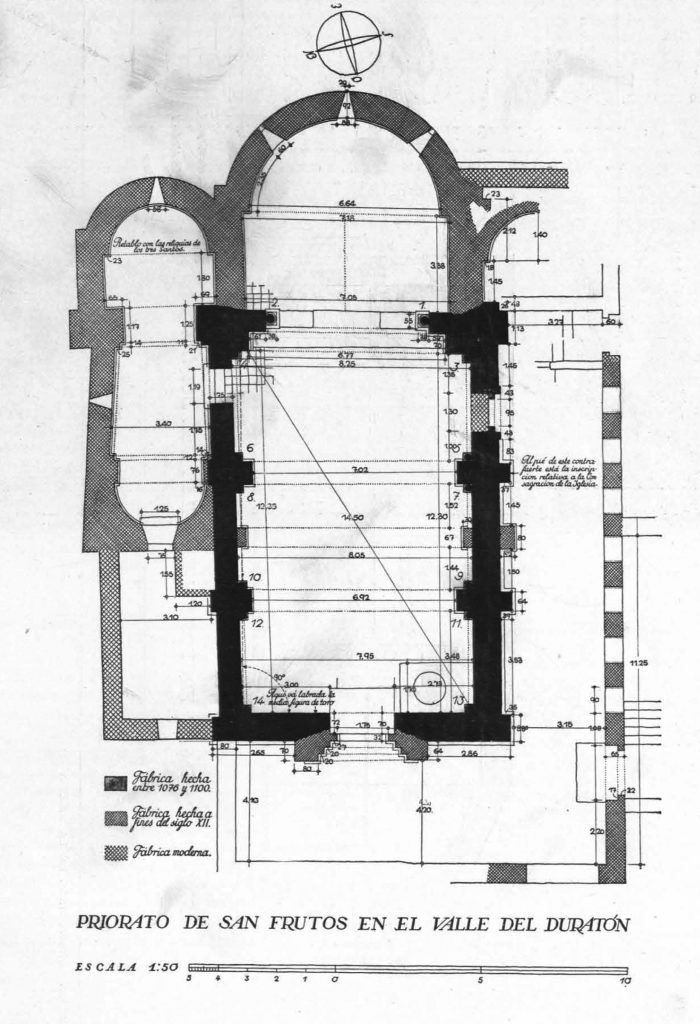
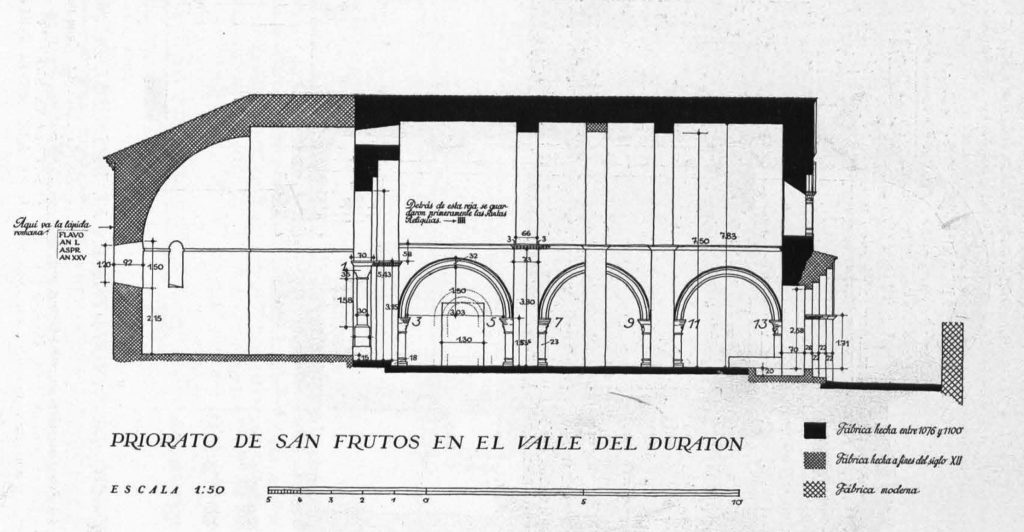

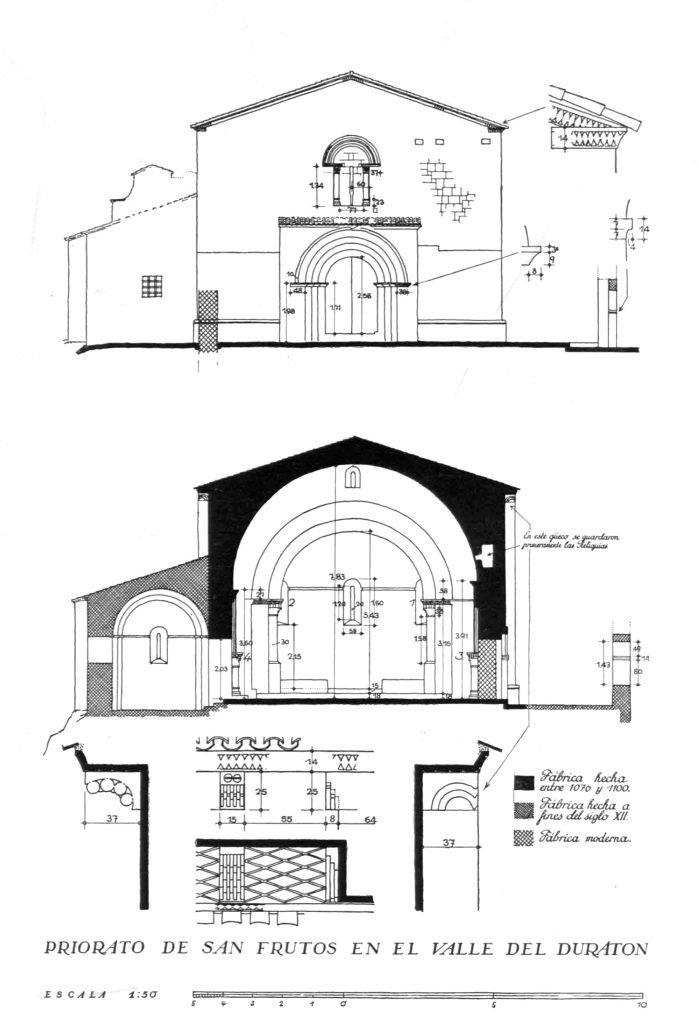
The hermitage is a 12th-century Romanesque construction that was built on top of a 7th-century Visigothic one. Its foundation is attributed to San Frutos (642 – 715) and his two brothers, San Valentín and Santa Engracia, who chose the site to dedicate themselves to the contemplative life. The complex was later completed with a monastery and a cemetery. From here you have the best-known view of the gorges, as it is one of the most attractive places in the park.
Access to the religious complex is via a small stone bridge built in 1757 over a crevice, La Cuchillada. Between the crevice and the hermitage are the remains of a Benedictine monastery. A little further on is the hermitage and at the foot of its apse there are several anthropomorphic tombs dating from the High Middle Ages and related to the reconquest of the area by Fernán González in the 10th century and reused by the monks of the priory. Between the religious complex and the edge of the cliff is a cemetery and next to it, in a small building, are the tombs that tradition has attributed to the saint and his two brothers, now empty. On the left side of La Cuchillada are the remains of a primitive staircase carved into the rock to descend to the bottom of the canyon.
At the entrance to the complex there is an iron cross on a stone pedestal bearing the seven keys of Sepúlveda. This cross was erected in 1900 to commemorate the great pilgrimage that took place that year under the auspices of the bishop of Segovia Quesada. In these parts the number seven has special relevance, being a constant in the area: the seven miracles of San Frutos, the seven gates of Sepúlveda, the cave of the Seven Altars, etc.
La ermita es una construcción románica de siglo XII que se realizó sobre otra visigótica del siglo VII. La fundación se atribuye a San Frutos (642 – 715) y sus dos hermanos, San Valentín y Santa Engracia, que eligieron el lugar para dedicarse a la vida contemplativa. Posteriormente se completó el complejo con un monasterio y un cementerio. Desde aquí se ofrece la vista más conocida de las hoces al ser uno de los lugares más atractivos del parque.
Se accede al complejo religioso mediante un pequeño puente de piedra construido en 1757 que salva una grieta, La Cuchillada. Entre la grieta y la ermita están los restos de un monasterio benedictino. Un poco más adelante se encuentra la ermita y al pie de su ábside se conservan varias tumbas antropomórficas datadas en la Alta Edad Media y relacionadas con la reconquista de la zona por Fernán González en el siglo X y reutilizadas por los monjes del priorato. Entre el complejo religioso y el borde del acantilado se ubica un cementerio y a su lado, en una pequeña construcción, se encuentran las tumbas que la tradición adjudica al santo y sus dos hermanos, ahora vacías. Al lado izquierdo de La Cuchillada quedan los restos de una primitiva escalera tallada en la roca para bajar al fondo del cañón.
A la entrada del complejo hay una cruz de hierro sobre un pedestal de piedra en el que figuran las siete llaves de Sepúlveda. Esta cruz fue levantada en el año 1900 para conmemorar la gran peregrinación que se realizó ese año auspiciada por el obispo de Segovia Quesada. En estos lares el número siete tiene especial relevancia siendo una constante en la zona: los siete milagros de San frutos, las siete puertas de Sepúlveda, la cueva de los Siete Altares, etc.
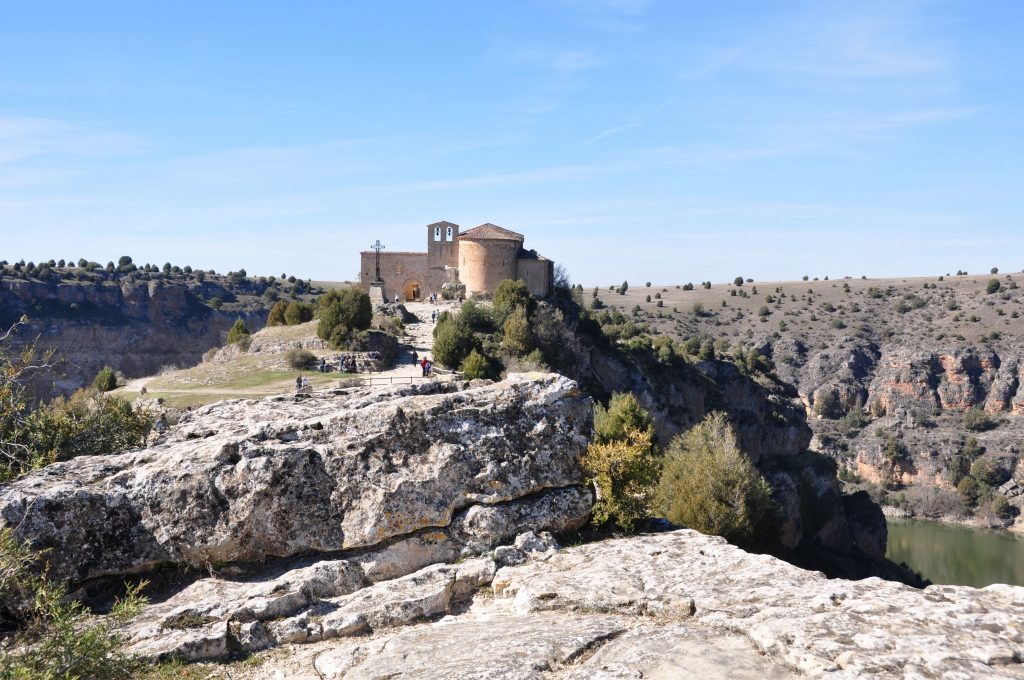
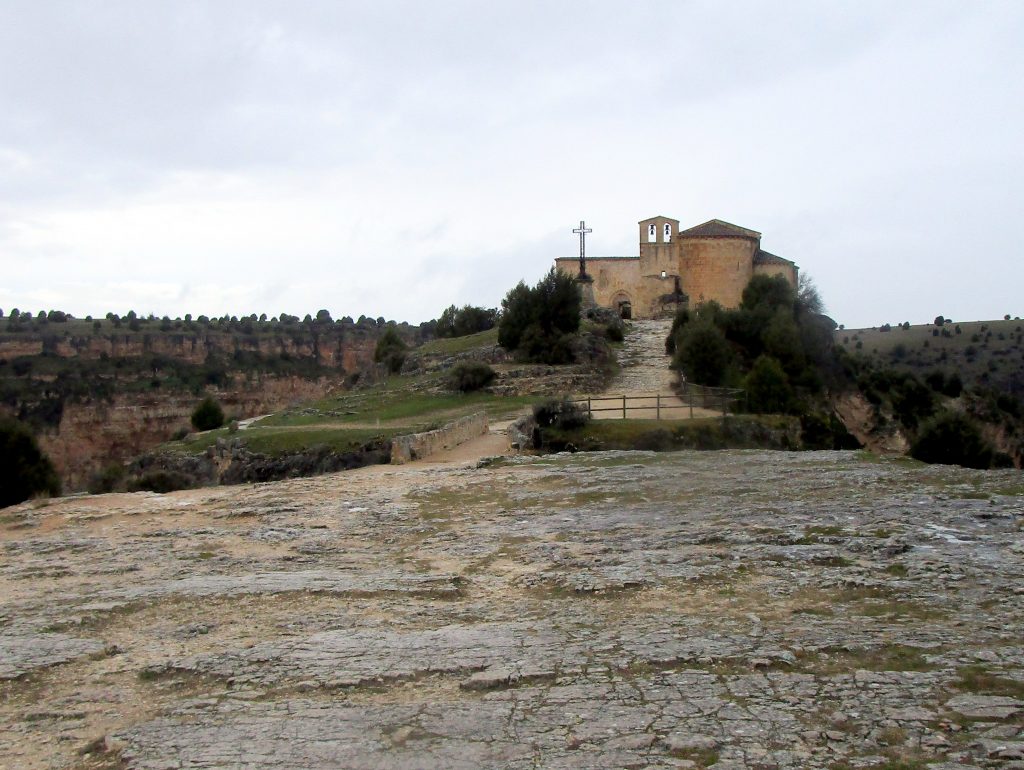
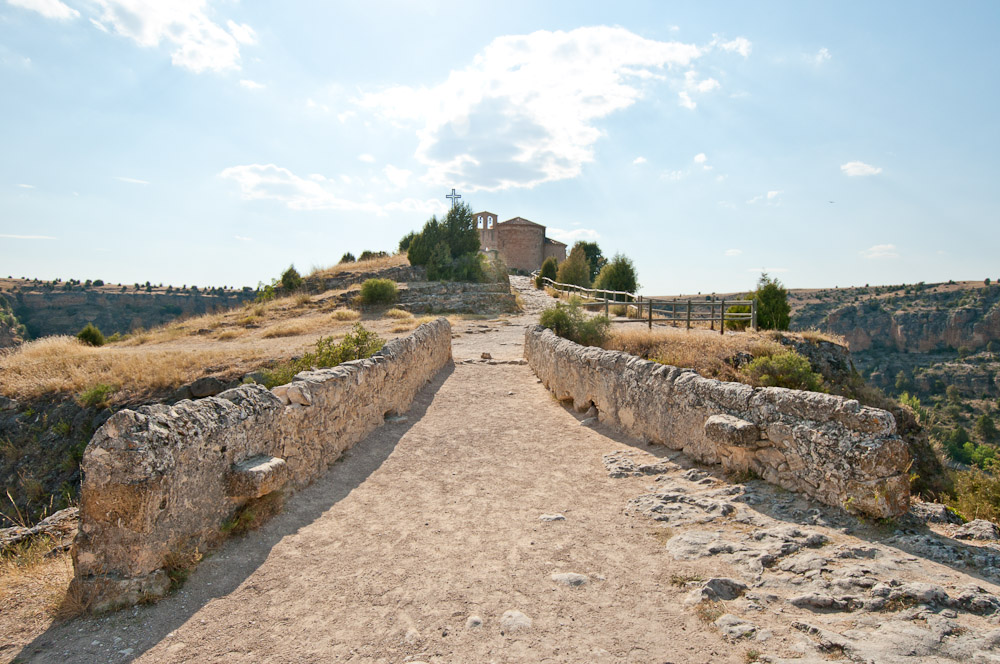
The church was begun in 1093 and consecrated in 1100 by the archbishop of Toledo, Bernardo de Sedirac, on the remains of Roman constructions. Its construction is attributed to a monk called Michael, the Abbot being Fortunio. It consists of a single 8-metre wide nave with double blind arcades on each side that are raised on small columns and covered by a barrel vault in three sections and a lowered triumphal arch, at the back of the nave is the apse.3 It is accessed through two doors, the one on the north side is the main one, the other is walled up. It is made up of three archivolts and a dust cap. The archivolts are supported by crests decorated with vegetal motifs and plain basins. The whole protrudes from the plane of the façade. Above it is a window formed by a semicircular arch supported by small columns with undecorated capitals. The arch has a chequered moulding and a plain moulding. There is a collection of 14 capitals with vegetal ornamentation and mythological scenes. It has undergone several alterations that have affected the apse as well as two lateral additions.
The temple was renovated in the 12th century with three new semicircular apses, but it was not until the beginning of the 18th century that important works were carried out inside the church. A new altarpiece was made for the altar of San Frutos and his relics were transferred there. A few years later the new chapel for the saint was built.
La iglesia se comenzó a construir en el año 1093 y fue consagrada en el año 1100 por el arzobispo de Toledo Bernardo de Sedirac.Se halla sobre restos de construcciones romanas. Su construcción está atribuida a un monje llamado Michael siendo el Abad Fortunio. Consta de una sola nave de 8 metros de ancho con dobles arquerías ciegas a sus lados que se levantan sobre pequeñas columnas y se cubre por una bóveda de cañón en tres tramos y arco de triunfo rebajado, al fondo de la nave esta el ábside.3 Su acceso se realiza a través de dos puertas, la del lado norte es la principal, la otra está tapiada. Está formada por tres arquivoltas y guardapolvo. Las arquivoltas apoyan en cimarios adornados con motivos vegetales y en piletas lisas. Todo el conjunto sobresale del plano de la fachada. Sobre él se abre una ventana que se forma con un arco de medio punto apoyado en columnillas con capiteles exentos de decoración. El arco tiene un guardapolvos ajedrezado y baquetón liso. Hay que destacar una colección de 14 capiteles con ornamentación vegetal y escenas mitólogicas. Ha sufrido varias remodelaciones que han afectado al ábside además de dos añadidos laterales.
El templo se reformó en el siglo XII con tres nuevos ábsides semicirculares, pero no fue hasta comienzos del siglo XVIII cuando se realizaron obras importantes en el interior de la iglesia. Se hizo un retablo nuevo para el altar de San Frutos y se trasladaron allí sus reliquias. Unos años más tarde se construyó la capilla nueva para el santo.
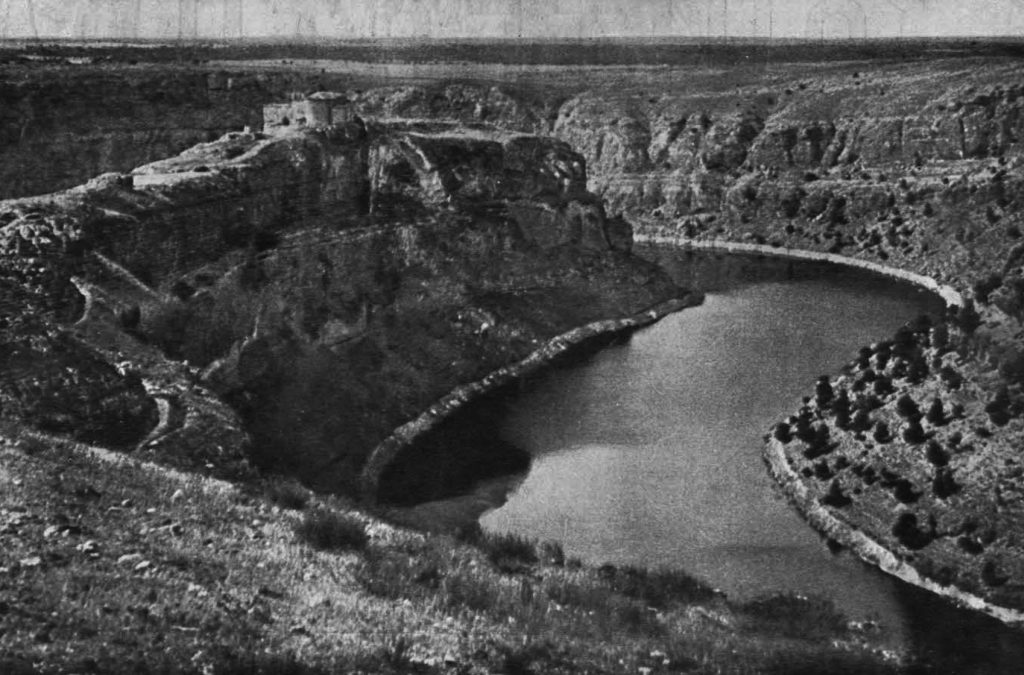
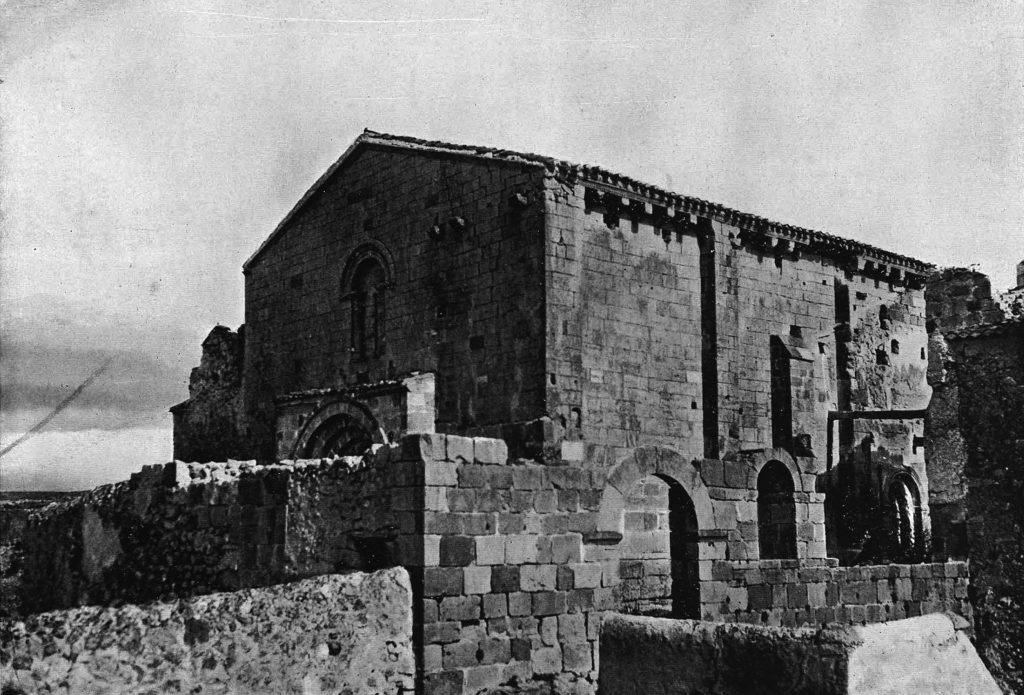
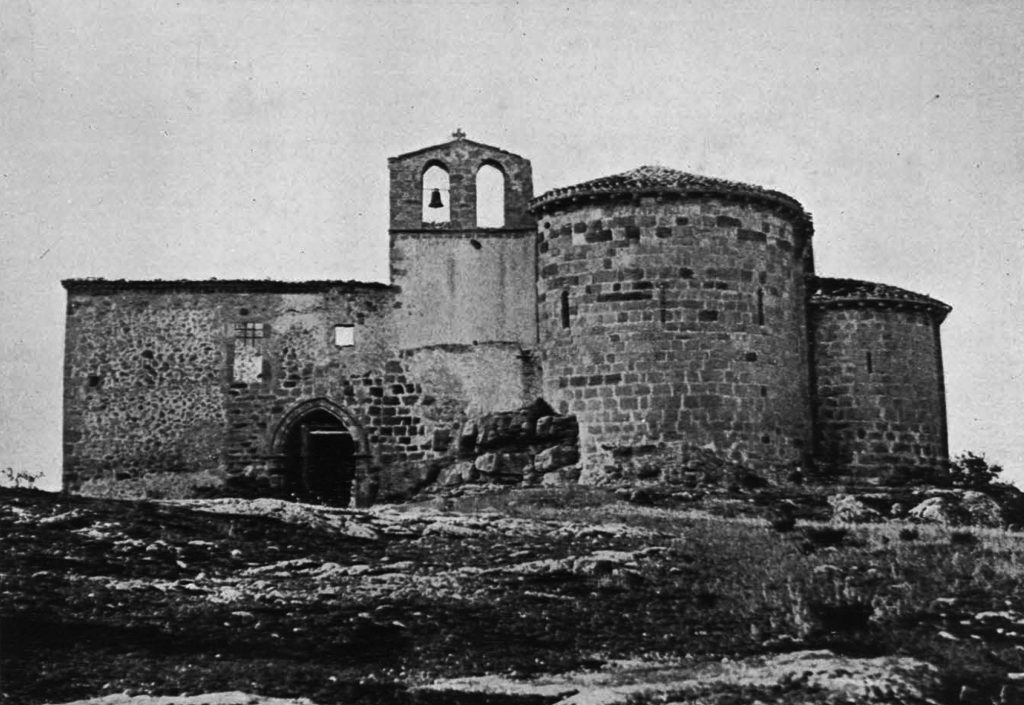
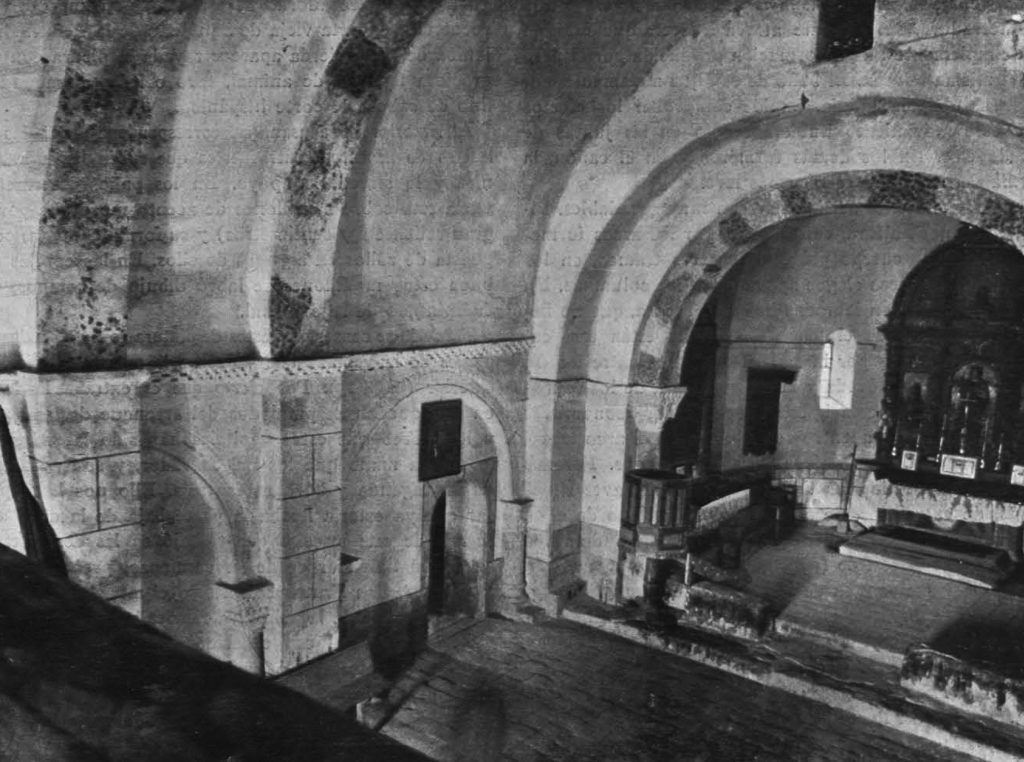
On 18th June 1126, King Alfonso VII of León granted a charter to populate the monastery of San Frutos and confirmed the annexation of this place to the monastery of Santo Domingo de Silos. The Benedictine monks remained there until they were forced to abandon the premises due to the disentailment of Mendizábal in 1834.2 Abandonment and a fire in the 19th century led to the monument’s ruin. In June 1931 it was classified as a National Monument.
San Frutos is the patron saint of the province of Segovia and on 25 October a pilgrimage is held in his honour. In 1992, the Brotherhood of San Frutos del Duratón was created and is responsible for the conservation of the site.
El 18 de junio de 1126 el rey Alfonso VII de León concedió fuero para poblar el monasterio de San Frutos y confirmó la anexión de este lugar al monasterio de Santo Domingo de Silos. La presencia de los monjes benedictinos se mantuvo hasta que se vieron obligados a abandonar las instalaciones debido a la desamortización de Mendizábal en 1834.2 El abandono y un incendio ocurrido en el siglo XIX acabaron llevando a la ruina al monumento. En junio de 1931 fue calificado como Monumento Nacional.
San Frutos es el patrón de la provincia de Segovia y el 25 de octubre se realiza la romería en su honor. En 1992 se creó la Hermandad de San Frutos del Duratón que se encarga de la conservación del lugar.
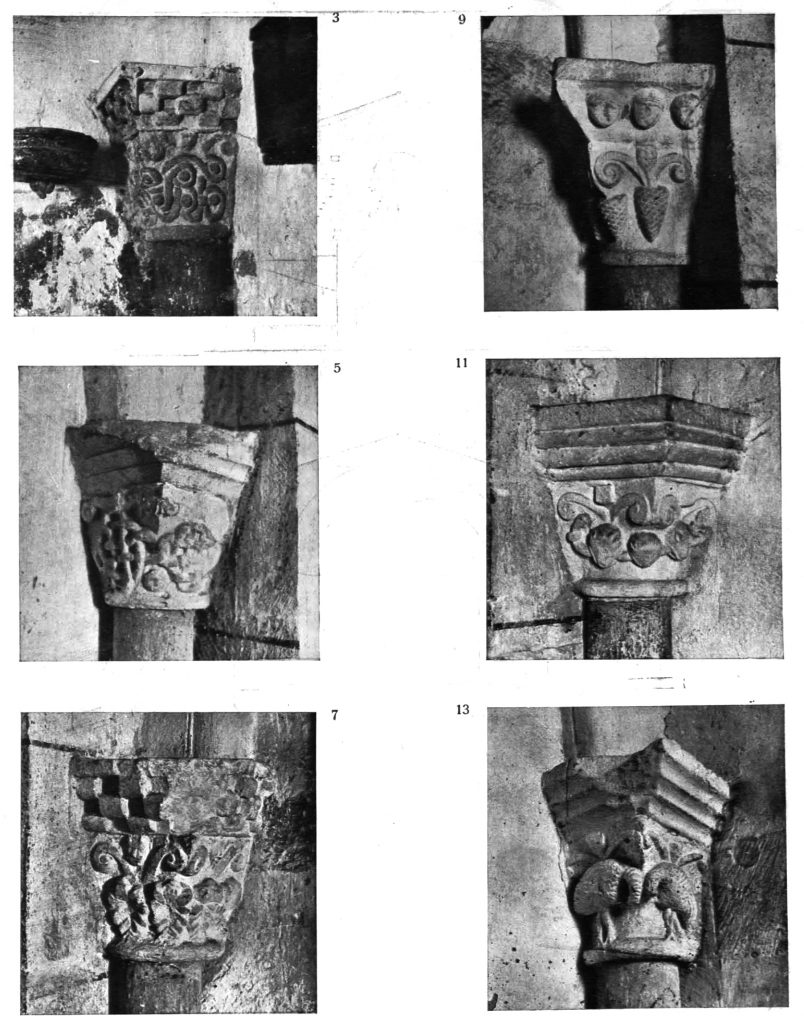
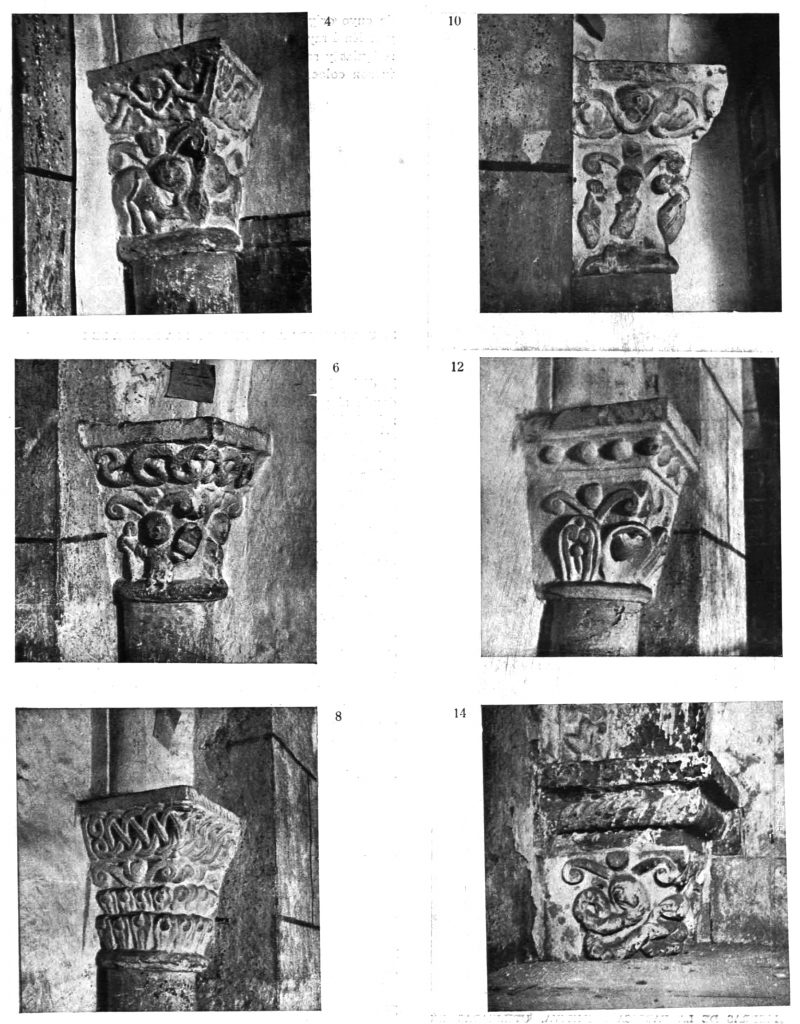
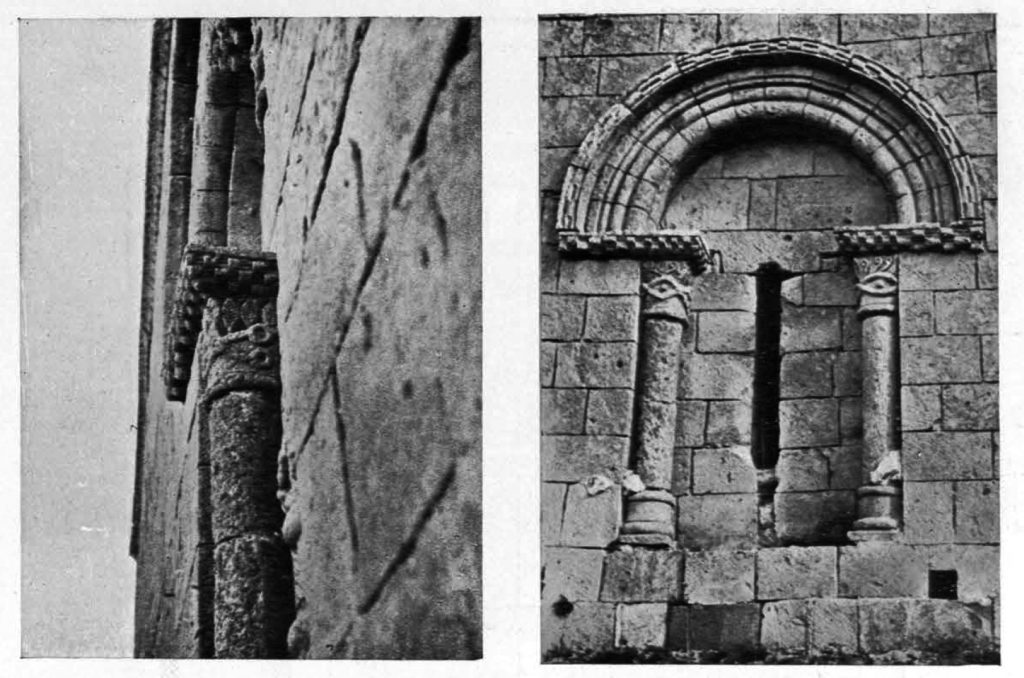
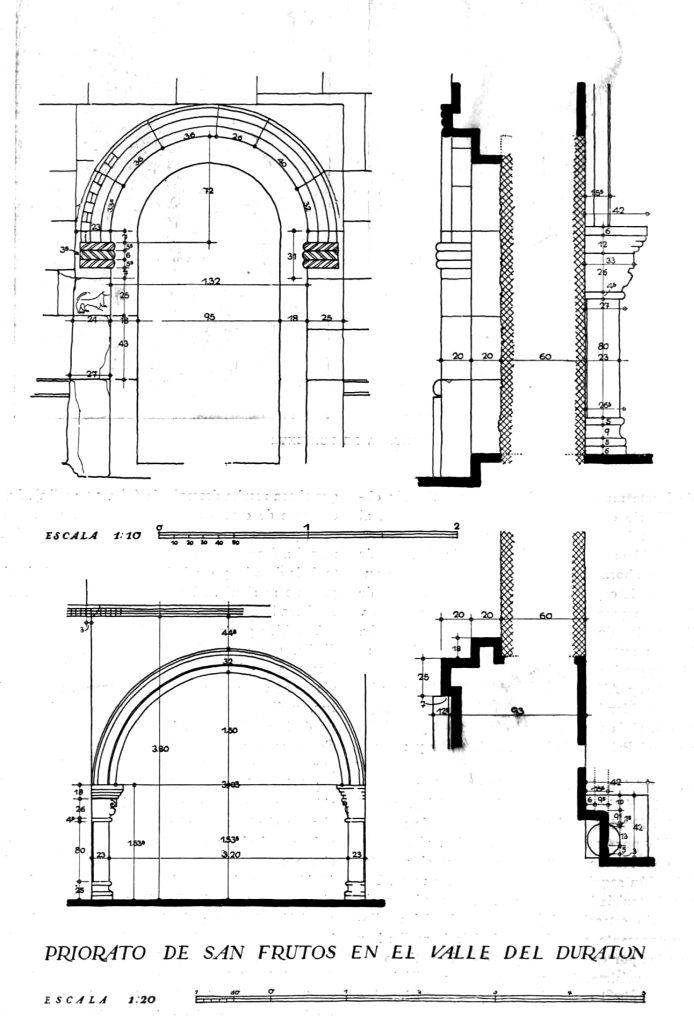
VIA:
Revista Arquitectura, n°163-164. 1932
Text from Wikipedia
